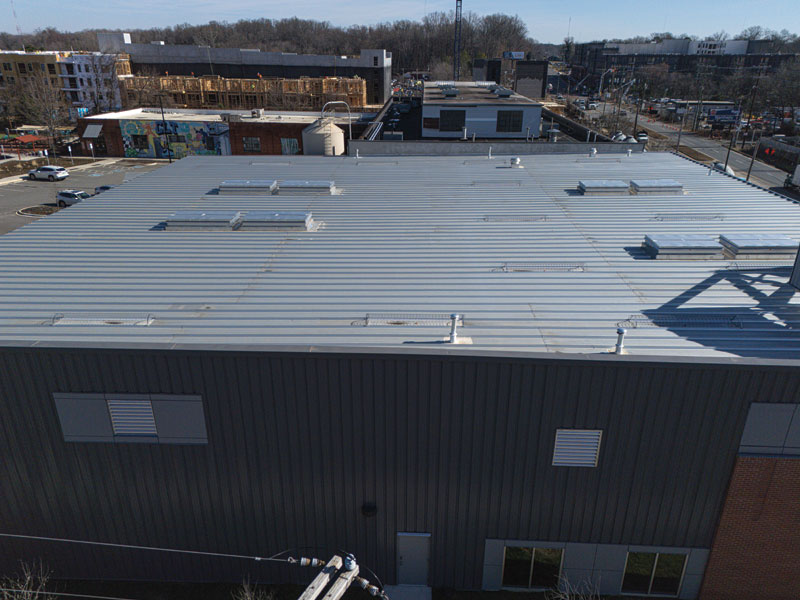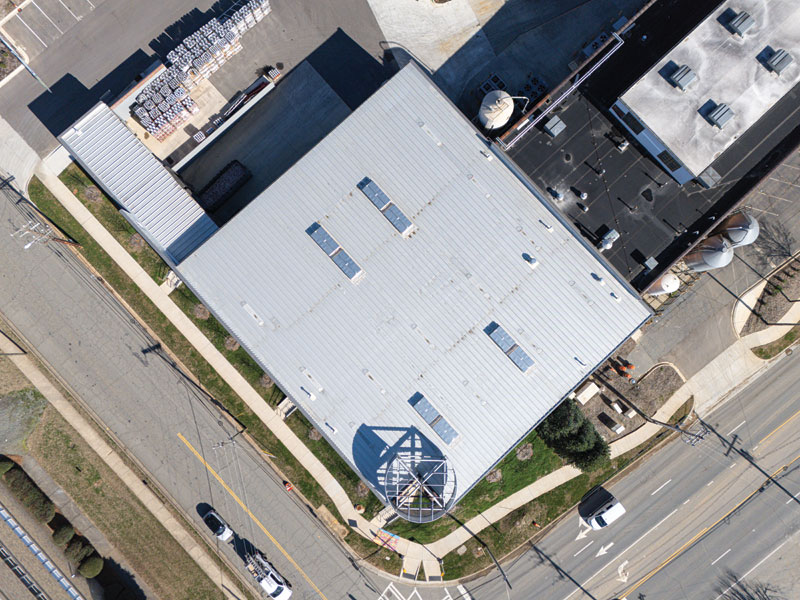
It is easier than ever to crack open a cold one at a craft brewery. According to the Brewers Association (BA), nearly 10,000 small and independent breweries in the United States contribute $77.1 billion to the economy. However, while the industry is booming, its operations often involve a high fire risk.

Fire risk in a growing industry
“The reality is that every brewery faces fire risk every single day of the year,” says Richard Beall, principal of Beall Brewer Insurance, on his company website. “There’s hot machinery, power tools, gas-powered vehicles, gas-fed flames, and loads of packaging material and paperwork. Think about it. Any craft brewery has plenty
of fodder for an accidental fire.”
When NoDa Brewing in Charlotte, N.C., expanded its facility by 1,486 m2 (16,000 sf), fire protection became a central part of the project. The $4-million expansion includes eight automatic smoke vents installed on a new 1,232-m2 (13,260-sf) standing seam metal roof. The design choice supports fire safety and reinforces the importance of coordinated metal roof and vent integration.
Integration of smoke vents and roof system
The smoke vents—four measuring 1.5 x 2.4 m (5 x 8 ft) and four measuring 1.5 x 3 m (5 x 10 ft)—were integrated with the help of Roof Curb Systems (RCS) of Georgia and general contractor Cummings Construction. RCS assisted in coordinating the smoke vents into the mechanically seamed, trapezoidal-profile roof system, ensuring long-term weather resistance and structural performance.
Smoke vents are well-suited for large, unobstructed spaces like breweries, warehouses, and industrial buildings. Activated by a fusible link, these vents automatically release smoke, heat, and gases in the event of a fire, improving visibility and aiding firefighter response.
“Choosing the proper smoke vent could mean saving a building and potentially lives in the event of a fire,’’ says Clifton Reasor, vice-president of business development for RCS. “Venting is that important. Smoke and heat vents improve visibility and reduce temperatures and hazardous gas concentrations. The enhanced visibility and reduction of gases and dangerous temperatures benefit escaping occupants and the firefighters who need to locate the fire. Our involvement in curb-mounted smoke vents goes back decades, and we apply that experience to ensure buildings have the right lifesaving, smoke evacuation system in place.”
Preliminary plans for the facility included sprinkler activation alone, but fire officials mandated the addition of smoke vents to meet code. Proper venting became a key component of the fire protection strategy, especially as the expansion allows NoDa Brewing to increase production by 40 percent.

Metal roof challenges and considerations
Coordinating vent curbs with standing seam roofing presented its own challenges.
“Rooftop equipment requires a solid foundation that embodies construction principles to ensure long-term structural performance and leak prevention,” Reasor explains.
The roof panels, featuring airtight high-rib field seams, demanded precision curb detailing to maintain weather-tightness.
“This was a single-skin metal roof project. We came into the mix to put all this together and ensure it will perform for the long term to exceed customer and owner expectations,” Reasor adds.
Learning from industry losses
A competitor in Charlotte suffered $1 million in fire damage and was forced to close temporarily. This has resulted in permanent closures.
“The vulnerability of craft breweries and distilleries to sudden, devastating fires is made more worrisome by the fact that many are located in dense retail districts using commercial structures not designed for heat-producing equipment,” notes Adjusters International in an industry report. The right roofing and fire protection systems—particularly those incorporating properly integrated metal components—can help mitigate those risks.
As the craft brewing industry grows, so does the need for fire-safe, performance-driven building systems. The right roofing and fire protection systems, particularly those incorporating properly integrated metal components, can help mitigate those risks.
Thomas Renner writes on building, construction, and other trade industry topics for publications throughout the United States. He is a writer for The Bilco Company, a manufacturer of specialty access products designed to provide secure and reliable access to commercial and residential spaces. For more information, visit www.bilco.com.


